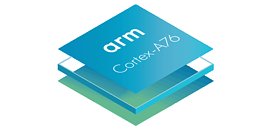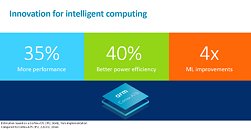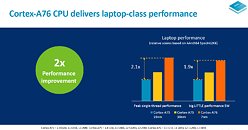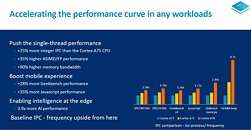Raevenlord
News Editor
- Joined
- Aug 12, 2016
- Messages
- 3,755 (1.19/day)
- Location
- Portugal
| System Name | The Ryzening |
|---|---|
| Processor | AMD Ryzen 9 5900X |
| Motherboard | MSI X570 MAG TOMAHAWK |
| Cooling | Lian Li Galahad 360mm AIO |
| Memory | 32 GB G.Skill Trident Z F4-3733 (4x 8 GB) |
| Video Card(s) | Gigabyte RTX 3070 Ti |
| Storage | Boot: Transcend MTE220S 2TB, Kintson A2000 1TB, Seagate Firewolf Pro 14 TB |
| Display(s) | Acer Nitro VG270UP (1440p 144 Hz IPS) |
| Case | Lian Li O11DX Dynamic White |
| Audio Device(s) | iFi Audio Zen DAC |
| Power Supply | Seasonic Focus+ 750 W |
| Mouse | Cooler Master Masterkeys Lite L |
| Keyboard | Cooler Master Masterkeys Lite L |
| Software | Windows 10 x64 |
ARM has announced their next, high-performance computing solution with their A76 design, which brings another large performance increase to the fledgling architecture. having been touted for some time as a true contender to the aging x86 architecture, ARM has had a way of extracting impressive performance increases with each iteration of its computing designs, in the order of 20% do 40% performance increases in an almost annual basis. Compare that to the poster-child of x86 computing, Intel, and its passivity-fueled 5 to 10% yearly performance increases, and the projections aren't that hard to grasp: at some point in time, ARM cores will surpass x86 in performance - at least on the mobility space.
The new ARM A76 design, to be manufactured on the 7 nm process, brings about a 35% increase in performance compared to last years' A75. This comes with an added 40% power efficiency (partly from the 10 nm to 7 nm transition, the rest from architecture efficiency and performance improvements), despite the increase to maximum 3.0 GHz clocks. With the added performance, ARM is saying the new A76 will deliver 4x the Machine Learning performance of its previous A75 design.



Adding to those CPU performance improvements, is ARM's Mali-G76 GPU solution, which also packs some 30% increases in performance density (meaning, for the same silicon footprint, added 30% performance), accompanied by 30% better energy efficiency and 2.7x increased Machine Learning performance for GPU-accelerated workloads. The new GPU architecture supports up to three execution engines per shader core, features a dual texture mapper, presents configurable 2-4 slices of L2 cache, and supports up to 20 "cores" in devices for process and workload distribution.



This combination of CPU (with the ARM A76) and GPU (with the Mali-G76) performance improvements mean that ARM is now within spitting distance of x86 solutions in the mobile space; this, and the future performance projections should ARM be able to keep its development and performance improvement pace, may be one of the reasons why Microsoft invested the way it did in adding ARM support for its Windows operating system in recent times. ARM solutions that employ Microsoft's OS do provide better battery life than their x86 counterparts, and with the latest ARM 76 improvements, which are seemingly more significant than any x86 performance and efficiency increases in recent times, may well mean a push for x86 towards higher levels of required performance, leaving the entry productivity and content consumption scenarios for ARM-powered devices and architectures.


View at TechPowerUp Main Site
The new ARM A76 design, to be manufactured on the 7 nm process, brings about a 35% increase in performance compared to last years' A75. This comes with an added 40% power efficiency (partly from the 10 nm to 7 nm transition, the rest from architecture efficiency and performance improvements), despite the increase to maximum 3.0 GHz clocks. With the added performance, ARM is saying the new A76 will deliver 4x the Machine Learning performance of its previous A75 design.



Adding to those CPU performance improvements, is ARM's Mali-G76 GPU solution, which also packs some 30% increases in performance density (meaning, for the same silicon footprint, added 30% performance), accompanied by 30% better energy efficiency and 2.7x increased Machine Learning performance for GPU-accelerated workloads. The new GPU architecture supports up to three execution engines per shader core, features a dual texture mapper, presents configurable 2-4 slices of L2 cache, and supports up to 20 "cores" in devices for process and workload distribution.



This combination of CPU (with the ARM A76) and GPU (with the Mali-G76) performance improvements mean that ARM is now within spitting distance of x86 solutions in the mobile space; this, and the future performance projections should ARM be able to keep its development and performance improvement pace, may be one of the reasons why Microsoft invested the way it did in adding ARM support for its Windows operating system in recent times. ARM solutions that employ Microsoft's OS do provide better battery life than their x86 counterparts, and with the latest ARM 76 improvements, which are seemingly more significant than any x86 performance and efficiency increases in recent times, may well mean a push for x86 towards higher levels of required performance, leaving the entry productivity and content consumption scenarios for ARM-powered devices and architectures.


View at TechPowerUp Main Site




